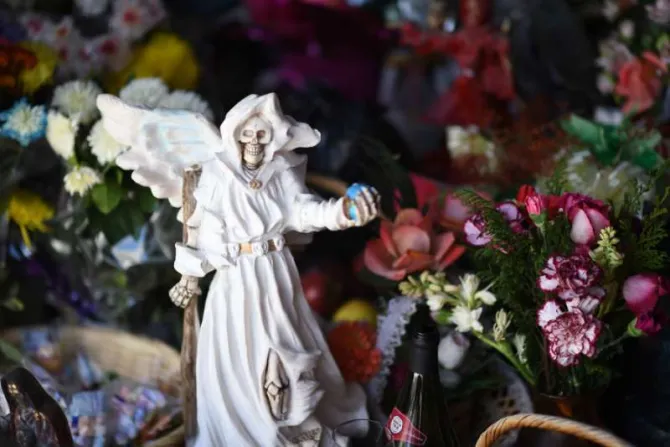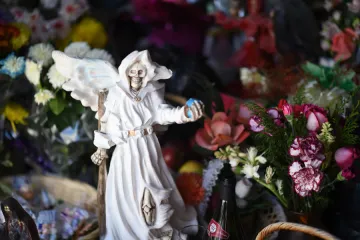Santa Fe, N.M., Mar 25, 2019 / 09:38 am
The Archbishop of Santa Fe said recently that people praying to "Saint Death" won't find the answers they're looking for.
Archbishop John Wester told the Associated Press recently that Catholics praying to the skeletal figure, popular in Central America, may be fooled into thinking that "Santa Muerte" is an approved devotional practice in the Church.
But the practice of praying to "Saint Death" is not consistent with Catholic teaching, the archbishop said.
"It's really wrong," Wester told the AP.
"I think in part, it's (because) people are looking and searching. It's a symptom of a search looking for answers."
"Our devotion is to the God of life," he added.
In 2013, a Vatican official condemned devotion to "Santa Muerte," equating it to "the celebration of devastation and of hell."
"It's not every day that a folk saint is actually condemned at the highest levels of the Vatican," Andrew Chesnut, a Santa Muerte expert, told CNA in 2016.
Chesnut is the Bishop Walter F. Sullivan Chair in Catholic Studies at Virginia Commonwealth University and author of "Devoted to Death: Santa Muerte, the Skeleton Saint," the only English academic book to date on the subject.
Despite her condemnation from on high, Santa Muerte remains increasingly popular among criminals, drug lords and those on the fringe of society, as well as cultural Catholics who maybe don't know (or care) that she is condemned by the Church.
"She's basically the poster girl of narco-satanic spirituality," Chesnut said.
According to Chesnut's estimates, Santa Muerte is the fastest growing religious movement in the Americas - and it's all happened within the past 10-15 years.
"She was unknown to 99 percent of Mexicans before 2001, when she went public. Now I estimate there's some 10-12 million devotees, mostly in Mexico, but also significant numbers in the United States and Central America," he said.
Part of the attraction to Santa Muerte, as several sources familiar with the devotion explained, is that she is seen as a non-judgemental saint that can be invoked for some not-so-holy petitions.
"If somebody is going to be doing something illegal, and they want to be protected from the law enforcement, they feel awkward asking God to protect them," Fr. Andres Gutierrez, the pastor of St. Helen parish in Rio Hondo, Texas, explained to CNA in 2016.
"So they promise something to Santa Muerte in exchange for being protected from the law."
(Story continues below)
Devotees also feel comfortable going to her for favors of vengeance - something they would never ask of God or a canonized saint, Chesnut said.
"I think this non-judgemental saint who's going to accept me as I am is appealing," Chesnut said, particularly to criminals or to people who don't feel completely accepted within the Mexican Catholic or Evangelical churches.
The cultural Catholicism of Mexico and the drug wars of the past decade also made for the perfect storm for Santa Muerte to catch on, Chesnut explained. Even Mexicans who didn't grow up going to Mass every Sunday still have a basic idea of what Catholicism entails - Mass and Saints and prayers like the rosary, all things that have been hi-jacked and adapted by the Santa Muerte movement.
"You can almost see some of it as kind of an extreme heretical form of folk Catholicism," he said. "In fact, I can say Santa Muerte could only have arisen from a Catholic environment."
This, coupled with the fact that Mexican Catholics are suddenly much more familiar with death, with the recent drug wars having left upwards of 60,000 - 120,000 Mexicans dead - makes a saint of death that much more intriguing.
"Paradoxically, a lot of devotees who feel like death could be just around the corner - maybe they're narcos, maybe they work in the street, maybe they're security guards who might be gunned down - they ask Santa Muerte for protection."
Her familiarity and appeal is actually part of the danger of this devotion, Fr. Gutierrez said.
"(Santa Muerte) is literally a demon with another name," he said. "That's what it is."
In his own ministry, Fr. Gutierrez said he has witnessed people who "suffer greatly" following a devotion to the folk saint.
Fr. Gary Thomas, a Vatican-trained exorcist for the Diocese of San Jose, told CNA in 2016 that he has also prayed with people who have had demonic trouble after praying to Santa Muerte.
"I have had a number of people who have come to me as users of this practice and found themselves tied to a demon or demonic tribe," he said.
Fr. Gutierrez noted that while Catholics who attend Mass and the sacraments on a regular basis tend to understand this about Santa Muerte, those in danger are the cultural Catholics who aren't intentionally engaging in something harmful, but could be opening the door to spiritual harm nonetheless.
Besides her demonic ties, "Santa Muerte" is also a perversion of what the practice of praying to saints is all about, Fr. Ryan Kaup, a Nebraska priest active in Hispanic ministry, told CNA in 2016.
"What we venerate as saints are real people who have chosen this life to follow the will of our Lord and have done great things with their lives, and now they're in heaven forever, and so that's why we ask for their intercession," Kaup said.
"So taking this devotion and this practice that we have of asking for this saint's intercession and twisting it in such a way as to invoke this glorified image of death is really a distortion of what we believe is true intercession and truly the power of the saints."



